

Otmar Halfmann, VP SFGV | FSJF
The following considerations for the direction of our family garden movement are based on direct experience and impressions in the Swiss environment. The extent to which these are transferable in whole or in part to other European countries must be assessed there.
For the members and functionaries of our Swiss association landscape, it is also painfully noticeable that there is no national legislation on which our allotment gardens can base themselves, but rather, with the exception of the Canton of Basel-Stadt, which has a constitutional anchoring of the "Besitzstand" surface, only various official regulations or also ... as in the case of the area where my wife and I cultivate our plot ... none.
This inevitably makes the exchange of experience between our officials more difficult, because in order to deal with a subject at the national level, one always has to know and keep an eye on the local peculiarities.
Developing or formulating generally valid, concrete goals under these conditions is much more difficult than where the legal framework is in place nationally.
But that is not all: the extent of official intervention can also vary; in one canton, for example, the waiting lists for plots are administered by the municipal gardening department and new members are assigned to the associations by the authorities when there is a change of tenant.
 It is encouraging that the interest in owning a garden plot continues unabated. After a peak in 2021 [Corona ...], the excess demand in the agglomerations still amounts to more than 20.0%.
It is encouraging that the interest in owning a garden plot continues unabated. After a peak in 2021 [Corona ...], the excess demand in the agglomerations still amounts to more than 20.0%.
On the other hand, we are losing more than 10.0 ha of open space every day through building or sealing for infrastructure projects, mainly in the already densely populated non-alpine regions.
In addition, the resident population [today almost 9.0 million ...] continues to grow rapidly; supplemented by a "cross-border commuter traffic" of almost half a million [with a good 5.0 million employees, this corresponds to almost 10.0 % ...] people living in France, Italy or Germany who come to work in Switzerland every day - mostly by car.
Furthermore, the legitimate renaturation of watercourses and riparian zones and the special protection of species-rich areas take up land.
And even excessive and largely commercialised recreational needs cannot do without land consumption, construction or sealing.
The starting point for finding a medium-term orientation for our family garden movement is further complicated by ecological requirements for plot management - which are of course undisputed, but differ from canton to canton. These requirements, in turn, unfortunately lead to an increase in conflicts within the associations themselves.
This increase in conflicts and the increasing technical and administrative demands on association boards are accompanied by an equally growing shortage of members who are willing to make themselves available for an honorary function.
This shortage will become even more serious in the coming years, because demographic change means that we are losing long-serving officials on a daily basis.
Raise association fees
In order to be able to work on all the different "fronts", associations need resources. If these resources are not available in the association due to a lack of suitable or professionally qualified people, service providers or craftsmen have to be commissioned.
If the association lacks the resources for this, it finds itself in a spiral towards implosion, which in some cases stretches over a period of infirmity.
Having sufficient regular income is the sine qua non for coping with various - existential - demands.
Relieving the burden on volunteers and strengthening the association's self-administration
Especially for large associations with hundreds of tenants spread over several areas, taking on a board function can often take up a full workload, all the more so as breaches of rules, arbitration between tenants, enforcement of official or regulatory requirements and legal disputes increase.
To prevent more and more committed members from giving up in disappointment after a short period on the board, these tasks must either be compensated accordingly [provided that members have the necessary time and professional qualifications ...] or, better still, outsourced entirely from the association to third parties. This externalises "minefields" for conflicts and thus protects cohesion.
At the same time, the board has more time for gardening or building issues.
Participation in spatial planning
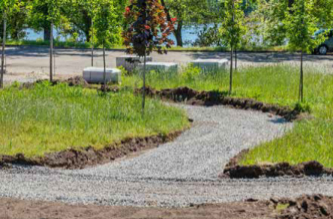 If the leases between the association and the landowner are not secured in the long term, or if there are foreseeable developments, proactive committee work at the community level is indispensable.
If the leases between the association and the landowner are not secured in the long term, or if there are foreseeable developments, proactive committee work at the community level is indispensable.
This is the only way to protect the association from surprises, the members from disappointment and to avoid bad investments on a collective and individual level.
If the destruction of an area is recognised at an early stage, it is much easier to start negotiations on replacement areas than if there is no more time available.
If the voters in a municipality* have already repeatedly approved a development that would wipe out the garden area, then it is already years too late for a protest in the media and any sympathy for those affected is no longer helpful at this point.
In a Swiss agglomeration, for example, our board member responsible there estimates that about 1/3 of the current sites are threatened. In such a situation, the board members must be able to concentrate on solutions as a matter of priority and with all available capacity.
*With "direct democracy", the power to decide on changes to communal zoning plans lies with the voters.
Cultivate alliance partnerships
Last year's important vote in four municipalities in the Zurich agglomeration on a zoning change for a local recreation area, which also affected a garden area there, shows how much we depend on alliances.
After a referendum was held there, which was initiated by renowned nature conservation organisations and locally respected people, primarily because of the biodiversity in the affected zone, nevertheless only a wafer-thin majority voted for the preservation of this "green lung".
If this partnership had not existed, the association would have been hopelessly overwhelmed. For the preservation of the garden plots alone, there would never have been even a referendum.
Even if these are unpleasant-sounding statements, they correspond to reality ... unfortunately.
In another large city, the voters have just decided in favour of two new buildings at the expense of two garden plots. Where housing is scarce and expensive, every project that could mitigate this is accepted.
Where it is promising to take legal action against projects, this will only be possible with the help of partners from the numerous nature conservation organisations.
Absorbing nature conservation projects and social initiatives
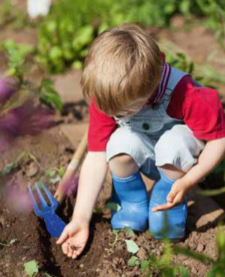 We are already doing a lot in species protection, but a lot is not enough: efforts to create and maintain ecological niches in the areas must be multiplied.
We are already doing a lot in species protection, but a lot is not enough: efforts to create and maintain ecological niches in the areas must be multiplied.
Media-communicative orientation is also of growing importance; not only the information itself, but also its continuous updating.
At which site is there already a poster, for example: "At our last hedgehog count in May, 34 hedgehogs were sighted, since we can assume a factor of 5 for the actual population, there are 180 hedgehogs on this site, which means 2 hedgehogs per plot and tenant"?
Wherever biodiversity [... also in plants] or its conservation is discussed in the neighbourhood or community environment - also in schools - we must be spontaneously present in the awareness of the population as a possible contact and possible partner.
This openness is also important towards social initiatives. At the moment, the integration efforts of refugees are in the foreground, but the spectrum is very broad and also dependent on local circumstances [is there, for example, a children's ridge around the corner that is currently looking for an area for "garden children"?]
Opening up and opening through, ... where necessary.
The area where I garden consists of two zones, with a road running between them. This road is also the connecting path to the local forest and a recreational area for countless walkers.
If this road did not exist, a thoroughfare would be indispensable for our area: the shortest connection between two points is and remains a line. We do not generate public sympathy if fellow citizens have to walk, for example, 800 m around a garden area until they reach the sports field, the cemetery or the multi-purpose hall.
Of course, thoroughfares have consequences, especially when they affect areas that have existed for decades: Fencing, litter, vandalism and security are all challenges. Finding a solution to this with the authorities is the constructive way to categorically reject it, which is counterproductive. For the preservation or possible expansion of our areas, the passive or better still active support of the population and our direct neighbours is indispensable.
The same applies to openings. In connection with a new development project, the city gardening department, which is involved in the planning, will implement an open "garden landscape". There will be garden islands in this zone. This will create an open, green zone that meets the local recreational needs of the residents. Analogous to the thoroughfare, such openings result in previously unknown problems not only for the associations but also for the municipality, which must be met with new solutions, because not everything new can or must always function immediately and by itself. Adaptations to new necessities are inevitably the result.
Insisting on the tradition of "gated communities" as customary law is futile and only generates resistance from the community.
Consistent deconstruction when plots are abandoned
If we want to credibly oppose building development, we must first show that we keep building and sealing to a minimum in our areas, i.e. that we often reduce it.
Currently, in the public and media perception - and that alone is decisive - more and more garden houses are being transformed into holiday homes.
It is disheartening that large stand-alone garden centres are now imposing requirements for deconstruction when tenants change: the associations probably lost the initiative here decades ago; it is imperative that we win it back.
Above all, this return to structural moderation is necessary with a view to avoiding conflicts between the association and members who are over-committed to construction: Conflicts do not end up in court because of a belatedly removed "thistle", but almost exclusively as a result of violations of building regulations and the like.
Subdivision of large plots before reallocation
In view of the continuing surplus demand and the younger, following generation, which is increasingly being challenged professionally, old garden houses should be demolished and large plots subdivided - if the initial conditions for this are available.
The new plots thus reduced in size should preferably only be leased with club-owned or precisely specified tool sheds.
Develop and implement design and maintenance concepts
Unfortunately, I know of no association that has a long-term design concept. This requirement is becoming more and more important as native woody plants and "eco-niches", among other things, gain in importance for species conservation.
Such a concept must also do justice to the increasing changes of tenants. With the departure of the "baby boomer" generation, tenancies of the past that lasted for decades are disappearing [unfortunately ...].
Similarly, in many places the maintenance of community facilities and buildings is reactive. I am not aware of any proactive maintenance concepts. The longer our areas exist, the more the "ravages of time" wear away at buildings, fences, paths or even hedges.
All these objects and their condition have an effect on the appearance.
Ensure prioritisation of common areas
Based on my own experience, I can state that the working time per square metre of garden area is about the same as the time I have to spend for a careful execution of "front work" outside or adjacent to our plot [again per square metre ...].
This is underestimated in the majority of the time requirements for community tasks. Again, it is not the individual well-kept plot that is representative of the garden area and the goodwill of third parties, but the overall picture.
In the first instance, we are not all tenants of a plot, but members of the association. It is only thanks to the existence of the association and the area leased by it that an individual plot can be available at all as a place of retreat in the countryside.
Enforce plot allocation criteria
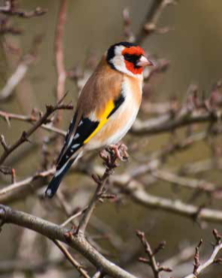 Plots are only to be allocated if and to those who qualify as applicants for association membership.
Plots are only to be allocated if and to those who qualify as applicants for association membership.
Without a probationary period, this will not be able to lead to an objective result. Only after one year of "candidacy" should a permanent lease be offered.
Countless disappointments could be avoided in this way.
Unfortunately, due to the high demand and the attractiveness of oversized garden houses, the habit has spread - despite numerous sensible barriers developed by clever association boards - that the previous tenant has a decisive say in who should take over his plot [and the garden house ...] depending on the amount of the down payment.
This practice must be stopped.
Note: It is much easier for an external property management company to implement this than for a president who is faced with a plot neighbour of decades' standing, which in turn underlines how sensible it can be to opt for outsourcing of administrative tasks.
Adjustments to land use laws for the parcels
Where new areas are being created, primarily as replacements for existing areas, it is possible for associations of a manageable size to forego sub-leasehold contracts for plots and to link membership of the association with an entitlement to the horticultural use of an area to be determined. This avoids the unfortunate linkage of leasehold and association law and thus simplifies the separation of "tenants", in this case only members, who cannot be integrated into the association.
Certainly, the exploitation of such an option is only possible very slowly and presupposes special conditions, also with regard to the responsible municipal gardening department, which usually represents the landowner.
Support for new members
New members are usually left alone with a pile of documents and the advice to please ask if there is something they do not understand or would like to change.
This is obviously not enough: Especially new members with limited knowledge of the national language are thus overwhelmed. It is understandable that when it comes to gardening, they first fall back on the imprints they have experienced in their cultural area.
Even if language restrictions are removed, we have to look more closely at the introduction of "newcomers" and, wherever experienced members are available, entrust them with such supervisory tasks.
If a newcomer has bought a "Thuya emerald" from the nearest nursery and only finds out weeks later during a garden inspection that it is forbidden to plant it in Zurich, the dispute is already pre-programmed.
Demarcation criteria
In Switzerland we have thousands of "wild" gardens; in our small town alone there is one large area and at least three smaller ones.
On both sides of the motorway that passes our town there is also a so-called garden area. The image that these "gardens" convey is pitiful. Such areas, which thousands of people drive past every day, help to shape our opinions, whether we like it or not.
That these "associations" do not belong to our federation is not communicable, how could it be?
In this respect, we have to develop demarcation criteria. Standards must be defined for this and implemented step by step.
Parallel to the implementation, this must be accompanied by appropriate communication content.
Likewise, the areas themselves must refer to these standards at their interfaces to the public.
This is the only way to create recognisable features and enable differentiation among our fellow citizens.
The family garden movement and numerous associations have been active for more than a hundred years, and our association will celebrate its centenary in 2025.
With a hundred years of experience, it should be possible for us to adapt to changing framework conditions and significantly intensifying competition for land use in a success-oriented manner.
Otmar Halfmann, VP SFGV | FSJF - Hyphen no. 79
Note 1: The author feels obliged to use the generic masculine form of language and asks for your understanding that he would like to dispense with gender asterisks for reasons of age.
Note 2: This contribution is not a position paper of the SFGV | FSJF. It reflects only the personal views of the author.
Our gardens are changing - hot summers, mild winters, heavy rains and long dry periods: All this presents gardeners with new challenges. It is time to make your own garden climate-proof!
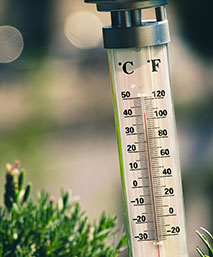 Reto Knutti is considered one of the world's leading climate researchers. As a professor of climate physics at ETH Zurich, he is one of the main authors of the last major report of the UN Intergovernmental Panel on Climate Change (IPCC). Recently, he said in an interview that without immediate action, a global average temperature increase of five degrees - in Switzerland probably even six or seven degrees - should be expected. Climate change presents us all with new challenges, which of course do not stop at us gardeners. When gardening, the following applies: "The right plant in the right place" and "gardening in the cycle of nature". Those who remain true to this principle should actually be able to continue to achieve a good harvest or enjoy their lush blooms in the future. However, we will have to take into account a few gardening facts that climate change brings with it. These include longer dry periods and heavy rainfall events as well as a longer growing season and milder winters.
Reto Knutti is considered one of the world's leading climate researchers. As a professor of climate physics at ETH Zurich, he is one of the main authors of the last major report of the UN Intergovernmental Panel on Climate Change (IPCC). Recently, he said in an interview that without immediate action, a global average temperature increase of five degrees - in Switzerland probably even six or seven degrees - should be expected. Climate change presents us all with new challenges, which of course do not stop at us gardeners. When gardening, the following applies: "The right plant in the right place" and "gardening in the cycle of nature". Those who remain true to this principle should actually be able to continue to achieve a good harvest or enjoy their lush blooms in the future. However, we will have to take into account a few gardening facts that climate change brings with it. These include longer dry periods and heavy rainfall events as well as a longer growing season and milder winters.
Climate change and climate protection
"Everyone who actively gardens, whether in their own garden or on the balcony, is a climate protector," says book author Verena Schubert (see book tip). Trees, shrubs and perennials process carbon dioxide (CO2) and produce oxygen. On the one hand, every plant helps to break down carbon dioxide. And on the other hand, home-grown fruit and vegetables also reduce transport and thus carbon dioxide emissions. Climate protection and recreational fun in one's own garden thus form - in the truest sense of the word - a fruitful combination.
Climate-friendly gardening
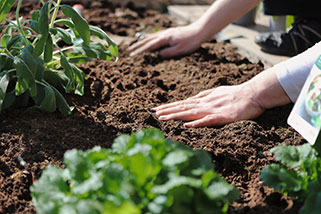 The path to a climate-friendly garden begins with the soil, whose fertility depends on the nutrient cycle. A plant returns the nutrients it extracts from the soil for its growth when it dies. Harvesting interrupts this cycle - with the harvest, nutrients are withdrawn from the soil, which - as fertiliser - have to be returned if a permanent harvest is to be made. But which fertiliser is the right one? "Synthetic chemical fertilisers and pesticides cause CO2 emissions in production and can also become environmental toxins," says Verena Schubert. She therefore consistently relies on natural fertilisers and plant fortification: "A good supply helps plants, animals and people to be robust and have good defences." Preventive plant fortification with extracts of field horsetail and comfrey and stinging nettle are, for example, the best plant protection! They increase the resistance of fruit, vegetable and ornamental plants, drive away pests with their smell and help the seeds to grow well. A few, such as tansy and garlic, can also fight fungal diseases. According to Verena Schubert, regular use ensures strong, robust and vital flora that can better withstand frost, heat and drought. In addition, these broths enrich the soil life, which makes nutrients available to the plants, and they also contain nitrogen, phosphorus, potassium and minerals themselves. "The best and cheapest fertiliser is your own compost!" the expert knows: "All garden waste is recycled in the compost and turned into valuable humus." By the way: compost is the ideal substitute for peat, which is unfortunately still used in large quantities. But peat cutting in the peatlands, which store large amounts of carbon dioxide, not only releases the carbon that has been stored since time immemorial in the form of CO2, thereby accelerating climate change, but also causes the creatures that live there to lose their habitat forever. Compost instead of peat is therefore the climate-friendly motto!
The path to a climate-friendly garden begins with the soil, whose fertility depends on the nutrient cycle. A plant returns the nutrients it extracts from the soil for its growth when it dies. Harvesting interrupts this cycle - with the harvest, nutrients are withdrawn from the soil, which - as fertiliser - have to be returned if a permanent harvest is to be made. But which fertiliser is the right one? "Synthetic chemical fertilisers and pesticides cause CO2 emissions in production and can also become environmental toxins," says Verena Schubert. She therefore consistently relies on natural fertilisers and plant fortification: "A good supply helps plants, animals and people to be robust and have good defences." Preventive plant fortification with extracts of field horsetail and comfrey and stinging nettle are, for example, the best plant protection! They increase the resistance of fruit, vegetable and ornamental plants, drive away pests with their smell and help the seeds to grow well. A few, such as tansy and garlic, can also fight fungal diseases. According to Verena Schubert, regular use ensures strong, robust and vital flora that can better withstand frost, heat and drought. In addition, these broths enrich the soil life, which makes nutrients available to the plants, and they also contain nitrogen, phosphorus, potassium and minerals themselves. "The best and cheapest fertiliser is your own compost!" the expert knows: "All garden waste is recycled in the compost and turned into valuable humus." By the way: compost is the ideal substitute for peat, which is unfortunately still used in large quantities. But peat cutting in the peatlands, which store large amounts of carbon dioxide, not only releases the carbon that has been stored since time immemorial in the form of CO2, thereby accelerating climate change, but also causes the creatures that live there to lose their habitat forever. Compost instead of peat is therefore the climate-friendly motto!
Diversity instead of monoculture
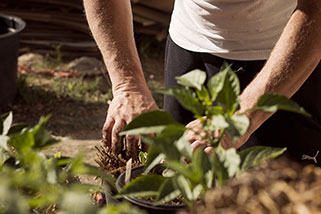 Many different plant species, mixed in a colourful way, ensure that the soil is not depleted one-sidedly and basically needs less nutrient supply. Certain plants are good neighbours and can strengthen and protect each other. "This plays a role especially in the vegetable garden," says Verena Schubert. "Onions and leeks planted next to carrots, for example, keep the carrot fly away. Savory protects against aphids, and nasturtiums in turn attract cabbage whitefly caterpillars, aphids and other pests. Cabbage plants and celery also help each other in this way. Celery rust and the caterpillars of the cabbage white butterfly will then be a thing of the past. Lettuce, on the other hand, keeps the infestation of ground fleas on radishes at bay.
Many different plant species, mixed in a colourful way, ensure that the soil is not depleted one-sidedly and basically needs less nutrient supply. Certain plants are good neighbours and can strengthen and protect each other. "This plays a role especially in the vegetable garden," says Verena Schubert. "Onions and leeks planted next to carrots, for example, keep the carrot fly away. Savory protects against aphids, and nasturtiums in turn attract cabbage whitefly caterpillars, aphids and other pests. Cabbage plants and celery also help each other in this way. Celery rust and the caterpillars of the cabbage white butterfly will then be a thing of the past. Lettuce, on the other hand, keeps the infestation of ground fleas on radishes at bay.
"With effective and simple measures, we can make our green oasis fit and at the same time positively influence the climate," Verena Schubert is convinced. Try it out?!
The pillars of the climate protection garden - tips from Verena Schubert
• If you garden with climate protection in mind, you do so with nature and not against it.
• Garden without the use of pesticides, synthetic chemical fertilisers and peat.
• Go for preventive plant strengthening, the right plant in the right location, plant diversity and compost management.
• Less is more: allowing and waiting are gardening virtues that make a natural garden possible in the first place.
Christina Bösiger - Hyphen no. 77
Example Switzerland: Plant Health Network Switzerland
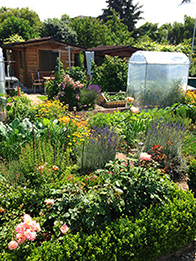 On 18th February 2021 the founding event of the “Plant Health Network Switzerland” took place; this in accordance with the prevailing circumstances as video-conference.
On 18th February 2021 the founding event of the “Plant Health Network Switzerland” took place; this in accordance with the prevailing circumstances as video-conference.
It had already become apparent during last year’s cooperation between authorities and federations for the “International Year of Plant Health 2020” that the work had to continue.
Luckily, all the previous main partners of the Federal Plant Protection Service are also involved in the “Network” including of course the Swiss allotment federation SFGV/FSJF.
Other institutions and federations will certainly join soon. The cantonal experts from Ticino will play here a special role, as this continues to be the main gateway for pests.
Due to the nationwide spreading of our garden areas, our plant diversity and the intensive cultivation of grounds with fruit, berries and vegetables, we have a special responsibility to support the authorities and scientific bodies in the identification, reduction and control of pests.
Additional information:
https://www.blw.admin.ch/blw/en/home/nachhaltige-produktion/Pflanzengesundheit/ihrbeitrag/netzwerk.html
Otmar Halfmann
President of the Swiss allotment federation